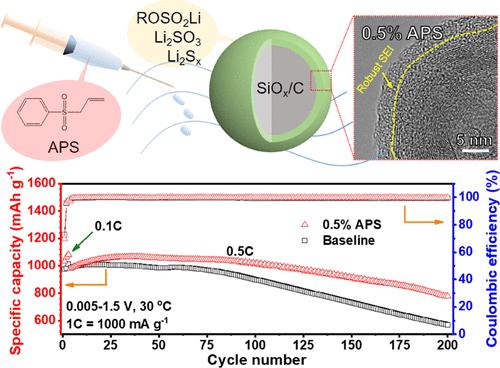当前位置:
X-MOL 学术
›
ACS Appl. Mater. Interfaces
›
论文详情
Our official English website, www.x-mol.net, welcomes your
feedback! (Note: you will need to create a separate account there.)
Strengthening the Interfacial Stability of the Silicon-Based Electrode via an Electrolyte Additive─Allyl Phenyl Sulfone
ACS Applied Materials & Interfaces ( IF 8.3 ) Pub Date : 2022-08-09 , DOI: 10.1021/acsami.2c08114
Gaopan Liu 1 , Jian Gao 1 , Meng Xia 1 , Yong Cheng 1, 2 , Mingsheng Wang 2 , Wenjing Hong 1 , Yong Yang 1 , Jianming Zheng 1
ACS Applied Materials & Interfaces ( IF 8.3 ) Pub Date : 2022-08-09 , DOI: 10.1021/acsami.2c08114
Gaopan Liu 1 , Jian Gao 1 , Meng Xia 1 , Yong Cheng 1, 2 , Mingsheng Wang 2 , Wenjing Hong 1 , Yong Yang 1 , Jianming Zheng 1
Affiliation

|
Silicon-based anodes have received widespread attention because of their high theoretical capacity, which, however, still faces challenges for practical applications due to the large volume changes during repeated charge/discharge processes, despite being developed for many years. Herein, we explore an electrolyte additive, allyl phenyl sulfone (APS), to enhance the interfacial stability and long-term durability of the SiOx/C electrode. It is revealed that additive APS contributes to forming a dense and robust solid electrolyte interphase film with high mechanical strength and favorable lithium-ion diffusion kinetics, which effectively suppresses the parasitic side reactions at the electrode-electrolyte interface. Meanwhile, the strong interaction between APS and trace water/acid in the electrolyte is further beneficial for enhancing the interfacial stability. By incorporating 0.5 wt% APS, the cycling stability of the silicon-based electrode is significantly improved, reserving a capacity of 777 mAh g–1 after 200 cycles at 0.5C and 30 °C (79.3% capacity retention), which well exceeds that of the baseline electrolyte (57.8% capacity retention). More importantly, additive APS effectively promotes the cycling performance of the corresponding SiOx/C||NCM90 (LiNi0.9Co0.05Mn0.05O2) full battery. This work provides valuable understanding in developing new electrolyte additives to enable the commercial application of high-energy density lithium-ion batteries using silicon-based anodes.
中文翻译:

通过电解质添加剂─烯丙基苯基砜增强硅基电极的界面稳定性
硅基负极因其较高的理论容量而受到广泛关注,然而,尽管已经开发多年,但由于反复充放电过程中体积变化大,实际应用仍面临挑战。在此,我们探索了一种电解质添加剂烯丙基苯基砜 (APS),以提高 SiO x的界面稳定性和长期耐久性。/C 电极。结果表明,添加剂APS有助于形成致密且坚固的固体电解质界面膜,具有高机械强度和良好的锂离子扩散动力学,有效抑制电极-电解质界面的寄生副反应。同时,APS与电解液中微量水/酸之间的强相互作用进一步有利于提高界面稳定性。通过加入 0.5 wt% APS,硅基电极的循环稳定性显着提高,容量为 777 mAh g –1在 0.5C 和 30°C 下循环 200 次后(79.3% 容量保持率),远远超过基准电解质(57.8% 容量保持率)。更重要的是,添加剂APS有效地促进了相应的SiO x /C||NCM90 (LiNi 0.9 Co 0.05 Mn 0.05 O 2 )全电池的循环性能。这项工作为开发新的电解质添加剂提供了有价值的理解,以使使用硅基阳极的高能量密度锂离子电池的商业应用成为可能。
更新日期:2022-08-09
中文翻译:

通过电解质添加剂─烯丙基苯基砜增强硅基电极的界面稳定性
硅基负极因其较高的理论容量而受到广泛关注,然而,尽管已经开发多年,但由于反复充放电过程中体积变化大,实际应用仍面临挑战。在此,我们探索了一种电解质添加剂烯丙基苯基砜 (APS),以提高 SiO x的界面稳定性和长期耐久性。/C 电极。结果表明,添加剂APS有助于形成致密且坚固的固体电解质界面膜,具有高机械强度和良好的锂离子扩散动力学,有效抑制电极-电解质界面的寄生副反应。同时,APS与电解液中微量水/酸之间的强相互作用进一步有利于提高界面稳定性。通过加入 0.5 wt% APS,硅基电极的循环稳定性显着提高,容量为 777 mAh g –1在 0.5C 和 30°C 下循环 200 次后(79.3% 容量保持率),远远超过基准电解质(57.8% 容量保持率)。更重要的是,添加剂APS有效地促进了相应的SiO x /C||NCM90 (LiNi 0.9 Co 0.05 Mn 0.05 O 2 )全电池的循环性能。这项工作为开发新的电解质添加剂提供了有价值的理解,以使使用硅基阳极的高能量密度锂离子电池的商业应用成为可能。

































 京公网安备 11010802027423号
京公网安备 11010802027423号